避碰规则全文(中英)
- 格式:doc
- 大小:182.00 KB
- 文档页数:31
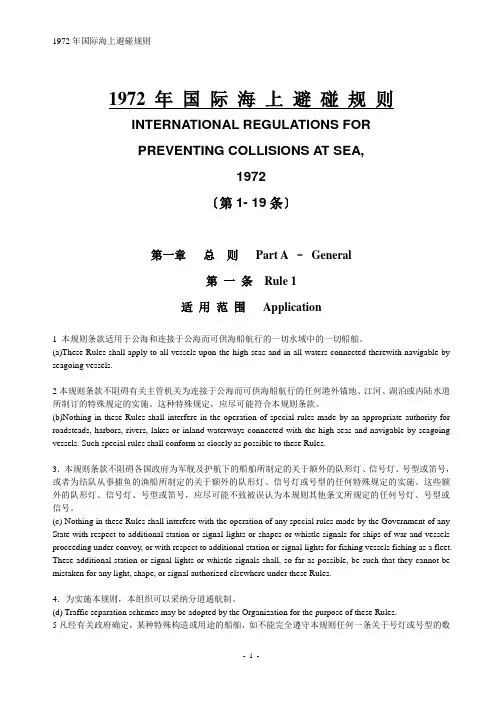
1972 年国际海上避碰规则INTERNATIONAL REGULATIONS FORPREVENTING COLLISIONS AT SEA,1972〔第1- 19条〕第一章总则Part A –General第一条Rule 1适用范围Application1 本规则条款适用于公海和连接于公海而可供海船航行的一切水域中的一切船舶。
(a)These Rules shall apply to all vessels upon the high seas and in all waters connected therewith navigable by seagoing vessels.2本规则条款不阻碍有关主管机关为连接于公海而可供海船航行的任何港外锚地、江河、湖泊或内陆水道所制订的特殊规定的实施。
这种特殊规定,应尽可能符合本规则条款。
(b)Nothing in these Rules shall interfere in the operation of special rules made by an appropriate authority for roadsteads, harbors, rivers, lakes or inland waterways connected with the high seas and navigable by seagoing vessels. Such special rules shall conform as closely as possible to these Rules.3.本规则条款不阻碍各国政府为军舰及护航下的船舶所制定的关于额外的队形灯、信号灯、号型或笛号,或者为结队从事捕鱼的渔船所制定的关于额外的队形灯、信号灯或号型的任何特殊规定的实施。
这些额外的队形灯、信号灯、号型或笛号,应尽可能不致被误认为本规则其他条文所规定的任何号灯、号型或信号。
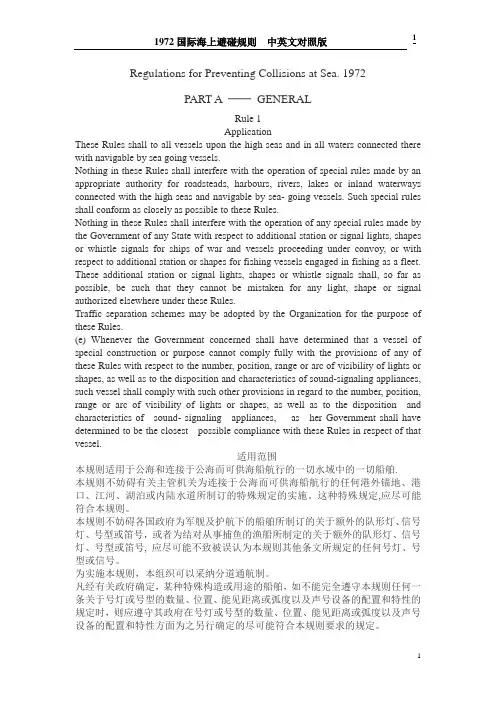
Regulations for Preventing Collisions at Sea. 1972PART A ──GENERALRule 1ApplicationThese Rules shall to all vessels upon the high seas and in all waters connected there with navigable by sea going vessels.Nothing in these Rules shall interfere with the operation of special rules made by an appropriate authority for roadsteads, harbours, rivers, lakes or inland waterways connected with the high seas and navigable by sea- going vessels. Such special rules shall conform as closely as possible to these Rules.Nothing in these Rules shall interfere with the operation of any special rules made by the Government of any State with respect to additional station or signal lights, shapes or whistle signals for ships of war and vessels proceeding under convoy, or with respect to additional station or shapes for fishing vessels engaged in fishing as a fleet. These additional station or signal lights, shapes or whistle signals shall, so far as possible, be such that they cannot be mistaken for any light, shape or signal authorized elsewhere under these Rules.Traffic separation schemes may be adopted by the Organization for the purpose of these Rules.(e) Whenever the Government concerned shall have determined that a vessel of special construction or purpose cannot comply fully with the provisions of any of these Rules with respect to the number, position, range or arc of visibility of lights or shapes, as well as to the disposition and characteristics of sound-signaling appliances, such vessel shall comply with such other provisions in regard to the number, position, range or arc of visibility of lights or shapes, as well as to the disposition and characteristics of sound- signaling appliances, as her Government shall have determined to be the closest possible compliance with these Rules in respect of that vessel.适用范围本规则适用于公海和连接于公海而可供海船航行的一切水域中的一切船舶.本规则不妨碍有关主管机关为连接于公海而可供海船航行的任何港外锚地、港口、江河、湖泊或内陆水道所制订的特殊规定的实施。
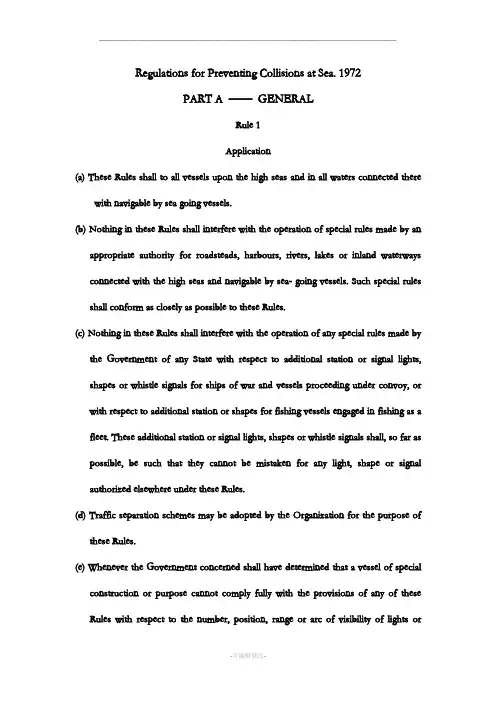
Regulations for Preventing Collisions at Sea. 1972PART A ──GENERALRule 1Application(a) These Rules shall to all vessels upon the high seas and in all waters connected therewith navigable by sea going vessels.(b) Nothing in these Rules shall interfere with the operation of special rules made by anappropriate authority for roadsteads, harbours, rivers, lakes or inland waterways connected with the high seas and navigable by sea- going vessels. Such special rules shall conform as closely as possible to these Rules.(c) Nothing in these Rules shall interfere with the operation of any special rules made bythe Government of any State with respect to additional station or signal lights, shapes or whistle signals for ships of war and vessels proceeding under convoy, or with respect to additional station or shapes for fishing vessels engaged in fishing as a fleet. These additional station or signal lights, shapes or whistle signals shall, so far as possible, be such that they cannot be mistaken for any light, shape or signal authorized elsewhere under these Rules.(d) Traffic separation schemes may be adopted by the Organization for the purpose ofthese Rules.(e) Whenever the Government concerned shall have determined that a vessel of specialconstruction or purpose cannot comply fully with the provisions of any of these Rules with respect to the number, position, range or arc of visibility of lights orshapes, as well as to the disposition and characteristics of sound-signaling appliances, such vessel shall comply with such other provisions in regard to the number, position, range or arc of visibility of lights or shapes, as well as to the disposition and characteristics of sound- signaling appliances, as her Government shall have determined to be the closest possible compliance with these Rules in respect of that vessel.第一条适用范围1.本规则适用于公海和连接于公海而可供海船航行的一切水域中的一切船舶.2.本规则不妨碍有关主管机关为连接于公海而可供海船航行的任何港外锚地、港口、江河、湖泊或内陆水道所制订的特殊规定的实施。

1972 年国际海上避碰规则INTERNATIONAL REGULATIONS FORPREVENTING COLLISIONS AT SEA,1972(第1- 19条)第一章总则Part A –General第一条Rule 1适用范围Application1 本规则条款适用于公海和连接于公海而可供海船航行的一切水域中的一切船舶。
(a)These Rules shall apply to all vessels upon the high seas and in all watersconnected therewith navigable by seagoing vessels.2本规则条款不妨碍有关主管机关为连接于公海而可供海船航行的任何港外锚地、江河、湖泊或内陆水道所制订的特殊规定的实施。
这种特殊规定,应尽可能符合本规则条款。
(b)Nothing in these Rules shall interfere in the operation of special rules madeby an appropriate authority for roadsteads, harbors, rivers, lakes or inland waterwaysconnected with the high seas and navigable by seagoing vessels. Suchspecial rulesshall conform as closely as possible to these Rules.3.本规则条款不妨碍各国政府为军舰及护航下的船舶所制定的关于额外的队形灯、信号灯、号型或笛号,或者为结队从事捕鱼的渔船所制定的关于额外的队形灯、信号灯或号型的任何特殊规定的实施。
这些额外的队形灯、信号灯、号型或笛号,应尽可能不致被误认为本规则其他条文所规定的任何号灯、号型或信号。
1 / 22(c) Nothing in these Rules shall interfere with the operation of any special rulesmade by the Government of any State with respect to additional station or signallights or shapes or whistle signals for ships of war and vessels proceeding underconvoy, or with respect to additional station or signal lights for fishing vessels fishingas a fleet. These additional station or signal lights or whistle signals shall, so far aspossible, be such that they cannot be mistaken for any light, shape, or signalauthorized elsewhere under these Rules.4.为实施本规则,本组织可以采纳分道通航制。
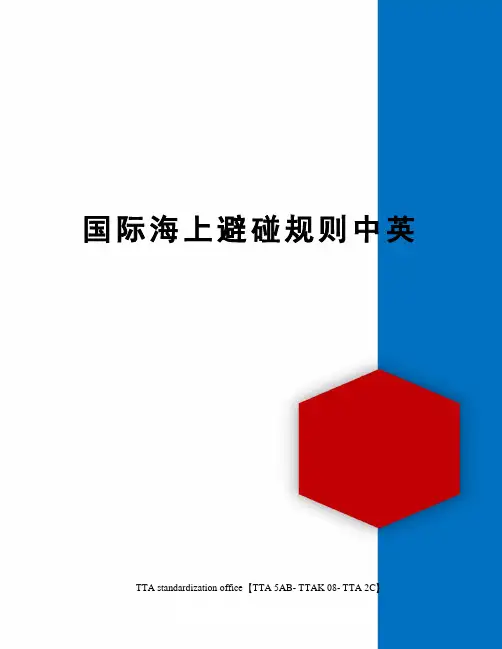
国际海上避碰规则中英 TTA standardization office【TTA 5AB- TTAK 08- TTA 2C】1972年国际海上避碰规则INTERNATIONAL REGULATIONS FORPREVENTING COLLISIONS AT SEA,1972(第1- 19条)第一章总则 Part A – General第一条 Rule 1适用范围 Application1 本规则条款适用于公海和连接于公海而可供海船航行的一切水域中的一切船舶。
(a)These Rules shall apply to all vessels upon the high seas and in all waters connected therewith navigable by seagoing vessels.2本规则条款不妨碍有关主管机关为连接于公海而可供海船航行的任何港外锚地、江河、湖泊或内陆水道所制订的特殊规定的实施。
这种特殊规定,应尽可能符合本规则条款。
(b)Nothing in these Rules shall interfere in the operation of special rules made by an appropriate authority for roadsteads, harbors, rivers, lakes or inland waterways connected with the high seas and navigable by seagoing vessels. Such special rules shall conform as closely as possible to these Rules.3.本规则条款不妨碍各国政府为军舰及护航下的船舶所制定的关于额外的队形灯、信号灯、号型或笛号,或者为结队从事捕鱼的渔船所制定的关于额外的队形灯、信号灯或号型的任何特殊规定的实施。
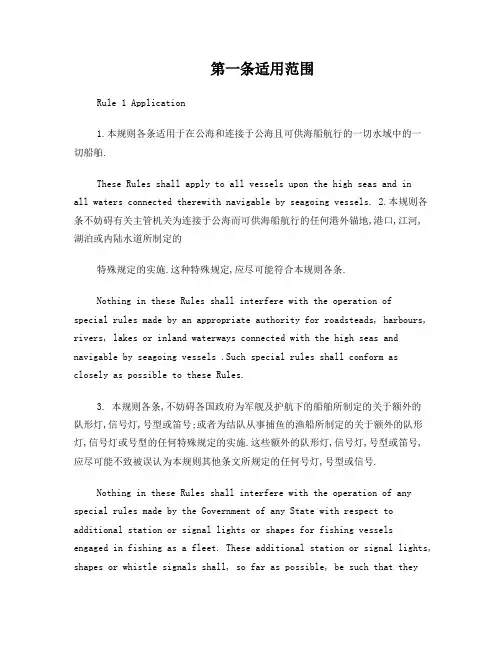
第一条适用范围Rule 1 Application1.本规则各条适用于在公海和连接于公海且可供海船航行的一切水域中的一切船舶.These Rules shall apply to all vessels upon the high seas and inall waters connected therewith navigable by seagoing vessels. 2.本规则各条不妨碍有关主管机关为连接于公海而可供海船航行的任何港外锚地,港口,江河,湖泊或内陆水道所制定的特殊规定的实施.这种特殊规定,应尽可能符合本规则各条.Nothing in these Rules shall interfere with the operation ofspecial rules made by an appropriate authority for roadsteads, harbours, rivers, lakes or inland waterways connected with the high seas and navigable by seagoing vessels .Such special rules shall conform asclosely as possible to these Rules.3. 本规则各条,不妨碍各国政府为军舰及护航下的船舶所制定的关于额外的队形灯,信号灯,号型或笛号;或者为结队从事捕鱼的渔船所制定的关于额外的队形灯,信号灯或号型的任何特殊规定的实施.这些额外的队形灯,信号灯,号型或笛号,应尽可能不致被误认为本规则其他条文所规定的任何号灯,号型或信号.Nothing in these Rules shall interfere with the operation of any special rules made by the Government of any State with respect to additional station or signal lights or shapes for fishing vessels engaged in fishing as a fleet. These additional station or signal lights, shapes or whistle signals shall, so far as possible, be such that theycannot be mistaken for any light, shape or signal authorized elsewhere under these Rules.4.为实施本规则,本组织可以采纳分道通航制.Traffic separation schemes may be adopted by the Organization for the purpose of these Rules.5.凡经有关政府确定,某种特殊构造或用途的船舶,如不能完全遵守本规则任何一条关于号灯或号型的数量,位置,能见距离或弧度以及声号设备的配置和特性的规定时,则应遵守其政府在号灯或号型的数量,位置,能见距离或弧度以及声号设备的配置和特性方面为之另行确定的尽可能符合本规则要求的规定.Whenever the Government concerned shall have determined that a vessel of special construction or purpose cannot comply fully with the provisions of any of these Rules with respect to the number, position, range or arc of visibility of lights or shapes, as well as to the disposition and characteristics of sound-signalling appliances, such vessel shall comply with such other provisions in regard to the number, position ,range or arc of the visibility of lights or shapes, as well as to the disposition and characteristics of sound-signalling appliances, as her Government shall have determined to be the closest possible compliance with these Rules in respect of that vessel.第二条责任Rule 2 Responsibility1.本规则各条并不免除任何船舶或其所有人,船长或船员由于对遵守本规则各条的任何疏忽,或者对海员通常做法或当时特殊情况可能要求的任何戒备上的疏忽而产生的各种后果的责任.Nothing in these Rules shall exonerate any vessel, or the owner, master or crew thereof, from the consequences of any neglect to comply with these Rules or of the neglect of any precaution which may be required by the ordinary practice of seamen, or by the special circumstances of the case.2.在解释和遵行本规则各条规定时,应适当考虑到,为避免紧迫危险而需背离本规则各条规定的一切航行和碰撞的危险,以及任何特殊情况,其中包括当事船舶条件限制在内.In construing and complying with these Rules due regard shall be had to all dangers of navigation and collision and to any special circumstances, including the limitations of the vessels involved, which may make a departure from these Rules necessary to avoid immediate danger.第三条一般定义Rule 3 General definitions除其他条文另有解释外,在本规则中:For the purpose of these Rules, except where the context otherwise requires:1.“船舶”一词,指用作或者能够用作水上运输工具的各类水上船筏,包括非排水船舶,水上飞机和地效翼船.The word “vessel”includes every description of water craft, including non-displacement craft ,WIG craft and seaplanes, used or capable of being used as a means of transportation on water.2.“机动船”一词,指用机器推进的任何船舶.The term“power-driven vessel ”means ay vessel propelled by machinery.3.“帆船”一词,指任何驶帆的船舶,包括装有推进机器而不在使用者.The term “sailing vessel”means any vessel under sail providedthat propelling machinery, if fitted, is not being used.4.“从事捕鱼的船舶”一词,指使用网具绳钓拖网或其他使其操纵性能受到限制的渔具捕鱼的任何船舶,但不包括使用曳绳钓或其他并不使其操纵性能受到限制的渔具捕鱼的船舶.The term “vessel engaged in fishing”means any vessel fishing with nets, lines, trawls or other fishing apparatus which restrict manoeuvrability , but does not include a vessel fishing with trolling lines or other fishing apparatus which do not restrict manoeuvrability.5.“水上飞机”一词,包括为能在水面操纵而设计的任何航空器.The word“seaplane”includes any aircraft designed to manoeuvre on the water.6.“失去控制的船舶”一词,指由于某种异常的情况不能按本规则各条的要求进行操纵,因而不能给他船让路的船舶.The term “vessel not under command”means a vessel which through some exceptional circumstance is unable to manoeuvre as required by these Rules and is therefore unable to keep out of the way of another vessel.7.“操纵能力受到限制的船舶”一词,指由于工作性质,使其按本规则要求进行操纵的能力受到限制,因而不能给他船让路的船舶. 操纵能力受到限制的船舶一词应包括,但不限于下列船舶:The t erm “vessel restricted in her ability to manoeuvre”means a vessel which from the nature of her work is restricted in her ability to manoeuvre as required by these Rules and is therefore unable to keep out of the way of another vessel. The term vessels restricted in theirability to manoeuvre shall include but not be limited to:(1)从事敷设,维修或起捞助航标志,海底电缆或管道的船舶;A vessel engaged in laying, servicing or picking up a navigation mark, submarine cable or pipeline.(2)从事疏浚,测量或水下作业的船舶;A vessel engaged in dredging, surveying or underwater operations.(3)在航中从事补给或转运人员,食品或货物的船舶;A vessel engaged in replenishment or transferring persons, provisions or cargo while underway.(4)从事发放或回收航空器的船舶;A vessel engaged in the launching or recovery of aircraft.(5)从事清除水雷作业的船舶;A vessel engaged in mine clearance operations.(6)从事拖带作业的船舶,而该项拖带作业使该拖船及其被拖船偏离所驶航向的能力严重受到限制.A vessel engaged in a towing operation such as severely restricts the towing vessel and her tow in their ability to deviate from their course.8.“限于吃水的船舶”一词,指由于吃水与可航水域的水深和宽度的关系,致使其偏离航向的能力严重的受到限制的机动船.The term “vessel constrained by her draught ”means a power-driven vessel which, because of her draught in relation to the available depth and width of navigable water, is severely restricted in her ability to deviate from the course she is following.9.“在航”一词,指船舶不在锚泊,系岸或搁浅.The word“underway”means that a vessel is not at anchor, or made fast to the shore, or aground.10.船舶的“长度和宽度”是指其总长度和最大宽度.The words “length and breadth” of a vessel mean her length overall an d greatest breadth.11.只有当一船能自他船以视觉看到时,才应认为两船是在互见中.Vessel shall be deemed to be in sight of one another only when one can be observed visually from the other.12“能见度不良”一词,指任何由于雾,霾,下雪,暴风雨,沙暴或任何其他类似原因而使能见度受到限制的情况.The term “restricted visibility” me ans any condition in which visibility is restricted by fog, mist, falling snow, heavy rainstorms, sandstorms or any other similar causes.13.“地效翼船”是一种模式的船艇,其主要操作模式是利用表面效应在相当接近水面的高度飞行.The term “Wing-In-Ground (WIG) craft” means a multimodal craft which, in its main operational mode flies in close proximity to the surface-effect action.第四条适用范围Rule 4 application本节各条适用于任何能见度的情况Rules in this section apply in any condition of visibility.第五条了望Rule 5 look-out每一船舶应经常用视觉,听觉以及适合当时环境和情况下一切有效的手段保持正规的了望,以便对局面和碰撞危险作出充分的估计.Every vessel shall at all times maintain a proper look-out by sight and hearing as well as by all available means appropriate in the prevailing circumstances and conditions so as to make a full appraisal of the situation and of the risk of collision.第六条安全航速Rule 6 safe speed每一船舶在任何时候均应用安全航速行驶,以便能采取适当而有效的避碰行动并能在适合当时环境和情况的距离以内把船停住.在决定安全航速时,考虑的因素中应包括下列各点:Every vessel shall at all times proceed at a safe speed so that she can take proper and effective action to avoid collision and be stopped within a distance appropriate to the prevailing circumstances and conditions. In determining a safe speed the following factors shall be among those taken into account:1.对所有船舶: By all vessels:(1)能见度情况; the state of visibility;(2)通航密度,包括渔船或者任何其他船舶的密集程度;The traffic density including concentrations of fishing vessels or any other vessels.(3)船舶的操纵性能,特别是在当时情况下的冲程和回转性能;The manoeuvrability of the vessel with special reference to stopping distance and turning ability in the prevailing conditions. (4)夜间出现的背景亮光,诸如来自岸上灯光或本船灯光的反向散射;At night the presence of background light such as from shore lights or from backscatter of her own lights.(5)风,浪和流的状况以及靠近航海危险物的情况;The state of wind, sea and current, and the proximity of navigational hazards(6)吃水与可用水深的关系.The draught in relation to the available depth of water.2.对备有可使用的雷达的船舶,还需考虑:Additionally, by vessels with operational radar:(1)雷达设备的特性,效率和局限性;The characteristics, efficiency and limitations of the radar equipment.(2)所选用的雷达距离标尺带来的任何限制;Any constraints imposed by the radar range scale in use.(3)海况,天气和其他干扰源对雷达探测的影响;The effect on radar detection of the sea state, weather and other sources of interference.(4)在适当距离内,雷达对小船,浮冰和其他漂浮物有探测不到的可能性;The possibility that small vessels, ice and other floating objects may not be detected by radar at an adequate range.(5)雷达探测到的船舶数目,位置和动态;The number, location and movement of vessels detected by radar.(6)当用雷达测定附近船舶或其他物体的距离时,可能对能见度作出的更确切的估计.The more exact assessment of the visibility that may be possible when radar is used to determine the range of vessels or other objects in the vicinity.第七条碰撞危险Rule 7 risk of collision1.每一船舶应用适合当时环境和情况的一切有效手段断定是否存在碰撞危险,如有任何怀疑,则应认为存在这种危险. Every vessel shall use all available means appropriate to the prevailing circumstances and conditions to determine if risk of collision exists, if there is any doubt such risk shall be deemed to exists.2.如装有雷达设备并可使用的话,则应正确予以使用,包括远距离扫描,以便获得碰撞危险的早期报警,并对探测到的物标进行雷达标绘或与其相当的系统观察.Proper use shall be made of radar equipment if fitted and operational, including long-range scanning to obtain early warning of risk of collision and radar plotting or equivalent systematic observation of detected objects.3.不应当根据不充分的资料,特别是不充分的雷达观测资料作出推断.Assumptions shall not be made on the basis of scanty information, especially scanty radar information4.在断定是否存在碰撞危险时,考虑的因素中应包括下列各点:In determining if risk of collision exists the following considerations shall be among those taken into account:(1)如果来船的罗经方位没有明显的变化,每则应认为存在这种危险;Such risk shall be deemed to exist if the compass bearing of an approaching vessel does not appreciably change.(2)即使有明显的方位变化,有时也可能存在这种危险,特别是在驶近一艘很大的船舶或拖带船组时,或是在近距离驶近他船时.Such risk may sometimes exist even when an appreciable bearing change is evident, particularly when approaching a very large vessel or a tow or when approaching a vessel at close range.第八条避免碰撞的行动Rule 8 action to avoid collision1.为避免碰撞所采取的任何行动,应按照本章的规定进行.如当时环境许可,应是积极的,并应及早的进行和注意运用良好的船艺.Any action to avoid collision shall be taken in accordance with the Rules of this Part and shall, if the circumstances of the case admit, be positive, made in ample time and with due regard to the observance of good seamanship.2.为避免碰撞而作的航向和(或)航速的任何变动,如当时环境许可,应大的足以使他船用视觉或雷达观察时容易察觉到;应避免对航向和(或)航速作一连串的小变动.Any alteration of course and/or speed to avoid collision shall, if the circumstances of the case admit, be large enough to be readily apparent to another vessel observing visually or by radar; a succession of small alteration of course and/or speed should be avoided.3.如有足够的水域,则单用转向可能是避免紧迫局面的最有效行动,倘若这种行动是及时的,大幅度的并且不致造成另一紧迫局面.If there is sufficient sea-room, alteration of course alone may be the most effective action to avoid a close-quarters situation provided that it is made in good time, is substantial and does not result in another close-quarter situation.4.为避免与他船碰撞而采取的行动,应能导致在安全的距离驶过.应细心查核避让行动的有效性,直到最后驶过让清他船为止.Action taken to avoid collision with another vessel shall be such as to result in passing at a safe distance. The effectiveness of the action shall be carefully checked until the other vessel is finally past and clear.5.如需避免碰撞或需留有更多的时间来估计局面,船舶应当减速或者停止或倒转推进器把船停住.If necessary to avoid collision or allow more time to assess the situation, a vessel shall slacken her speed or take all way off by stopping or reversing her means of propulsion.6.(1)根据本规则任何规定,要求不得妨碍另一艘船舶通过或安全通过的船舶应根据当时环境的需要及早的采取行动以留出足够的水域供其它船舶安全通过.A vessel which, by any of these Rules, is required not to impede the passage or safe passage of another vessel shall, when required by the circumstances of the case, take early action to allow sufficientsea-room for the safe passage of the other vessel.(2)如果在接近其它船舶致有碰撞危险时,被要求不得妨碍另一船舶通过的船舶并不解除这一责任,且当采取行动时,应充分考虑到本章各条可能要求的行动.A vessel required not to impede the passage or safe passage of another vessel is not relieved of this obligation if approaching the other vessel so asto involve risk of collision and shall, when taking action ,have full regard to the action which may be required by the Rules of this part.(3)当两船互相接近致有碰撞危险时,其通过不得被妨碍的船舶仍有完全遵守本章各条规定的责任.A vessel the passage of which is not to be impeded remains fully obliged to comply with the Rules of this part when thetwo vessels are approaching one another so as to involve risk of collision.第九条狭水道Rule 9 narrow channels1.船舶沿狭水道或航道行驶时,只要安全可行,应尽量靠近本船右舷的该水道或航道的外缘行驶.A vessel proceeding along the course of a narrow channel or fairway shall keep as near to the outer limit of the channel or fairway which lies on her starboard side as is safe and practicable.2.帆船或者长度小于20米的船舶,不应妨碍只能在狭水道或航道以内安全航行的船舶通行.A vessel of less than 20 m in length or a sailing vessel shall not impede the passage of a vessel which can safely navigate only within a narrow channel or fairway.3.从事捕鱼的船舶,不应妨碍任何其它在狭水道或航道以内航行的船舶通行.A vessel engaged in fishing shall not impede the passage of any other vessel navigating within a narrow channel or fairway.4.船舶不应穿越狭水道或航道,如过这种穿越会妨碍只能在这种水道或航道以内安全航行的船舶通行.后者若对穿越船的意图有怀疑时,可以使用第三十四条4款所规定的声号.A vessel shall not cross a narrow channel or fairway if such crossing impedes the passage of a vessel which can safely navigate only within such channel or fairway. The latter vessel may use the sound signal prescribed in Rule 34(d)if in doubt as to the intention of the crossing vessel.5.(1)在狭水道或航道内,如只有在被追越船必须采取行动以允许安全通过才能追越时,则企图追越的船,应鸣放第三十四条3款(1)项所规定的相应声号,以表示本船的意图,被追越船如果同意,应鸣放第三十四条3款(2)项所规定的相应声号,并采取使之能安全通过的措施.如有怀疑,则可以鸣放第三十四条4款所规定的声号.In a narrow channel or fairway when overtaking can take place only if the vessel to be overtaken has to take action to permit safe passing, the vessel intending to overtake shall indicate her intention by sounding the appropriate signal prescribed in Rule 34( c) (i), The vessel to be overtaken shall, if in agreement, sound the appropriate signal prescribed in Rule34( c)(ii) and take steps topermit safe passing. If in doubt she may sound the signals prescribed in Rule 34(d).(2)本条并不解除追越船根据第十三条所负的义务.This Rule does not relieve the overtaking vessel of her obligation under Rule 13.6.船在驶近可能被居间障碍物遮蔽他船的狭水道或航道的弯头或地段时,应特别机警和谨慎的驾驶,并应鸣放第三十四条5款所规定的相应声号.A vessel nearing a bend or an area of a narrow channel or fairway where other vessels may be obscured by an intervening obstruction shall navigate with particular alertness and caution and shall sound the appropriate signal prescribed in Rule34(e) 7.任何船舶,如当时环境许可,都应避免在狭水道内锚泊.Any vessel shall, if the circumstances of the case admit, avoid anchoring in a narrow channel.第十条分道通航制Rule 10 Traffic separation schemes1.本条适用于本组织采纳的分道通航制,但并不解除任何船舶遵守任何其他各条规定的责任。
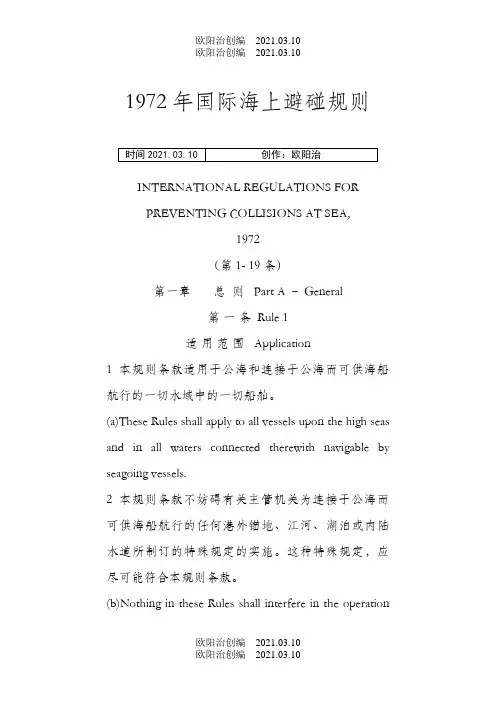
1972年国际海上避碰规则INTERNATIONAL REGULATIONS FORPREVENTING COLLISIONS AT SEA,1972(第1- 19条)第一章总则 Part A – General第一条 Rule 1适用范围 Application1 本规则条款适用于公海和连接于公海而可供海船航行的一切水域中的一切船舶。
(a)These Rules shall apply to all vessels upon the high seas and in all waters connected therewith navigable by seagoing vessels.2本规则条款不妨碍有关主管机关为连接于公海而可供海船航行的任何港外锚地、江河、湖泊或内陆水道所制订的特殊规定的实施。
这种特殊规定,应尽可能符合本规则条款。
(b)Nothing in these Rules shall interfere in the operationof special rules made by an appropriate authority for roadsteads, harbors, rivers, lakes or inland waterways connected with the high seas and navigable by seagoing vessels. Such special rules shall conform as closely as possible to these Rules.3.本规则条款不妨碍各国政府为军舰及护航下的船舶所制定的关于额外的队形灯、信号灯、号型或笛号,或者为结队从事捕鱼的渔船所制定的关于额外的队形灯、信号灯或号型的任何特殊规定的实施。
这些额外的队形灯、信号灯、号型或笛号,应尽可能不致被误认为本规则其他条文所规定的任何号灯、号型或信号。
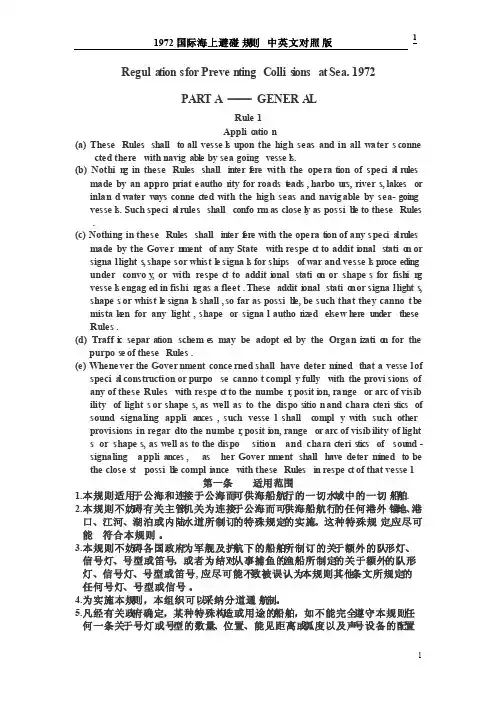
Regula tions for Preven ting Collis ions at Sea. 1972PART A ──GENERA LRule 1Applic ation(a) These Rules shall to all vessel s upon the high seas and in all waters connected therewith navigable by sea goingvessel s.(b) Nothin g in theseRules shall interf er e with the operation of specia l r ulesmade by an appropriate author ity for roadst eads, harbour s, rivers, lakesor inland waterw ays connec ted with the high seas and naviga ble by sea- goingvessel s. Such specia l rules shall confor m as closel y as possib l e to theseRules .(c) Nothin g in theseRules shall interf er e with the operat ion of any specia l r ulesmade by the Govern m ent of any Statewith respec t to additi onal statio n or signal lights, shapes or whistl e signal s for shipsof war and vessel s pr oceedingunderconvoy, or with respec t to additi onal statio n or shapes for fishin g vessel s engaged in fishin g as a fleet. Theseadditi onal statio n or signal lights, shapes or whistl e signal s shall, so far as possib l e, be such that they cannot be mistak en for any light,shapeor signal author iz edelsewh er e undertheseRules.(d) Traffi c separa tion scheme s may be adopte d by the Organiz atio n for thepurpos e of theseRules.(e) Whenev er the Govern mentconcer ned shallhave determ inedthat a vessel ofspecia l constr uctio n or purpos e cannot comply fullyw ith the provis ionsof any of theseRulesw ith respec t to the number, positi on, rangeor arc of visibilityof lights or shapes, as well as to the disposition and character is tics of sound-s ignal ing applia nces,such vessel shallc omply with such otherprovis ionsin regard to the number, positi on, rangeor arc of visibi lityof lights or shapes, as well as to the dispos ition and charac teris ticsof sound-signal ing applia nces,as her Governm ent shall have determ inedto be the closest possib l e compli ancew ith theseRulesin respec t of that vessel.第一条适用范围1.本规则适用于公海和连接于公海而可供海船航行的一切水域中的一切船舶.2.本规则不妨碍有关主管机关为连接于公海而可供海船航行的任何港外锚地、港口、江河、湖泊或内陆水道所制订的特殊规定的实施。
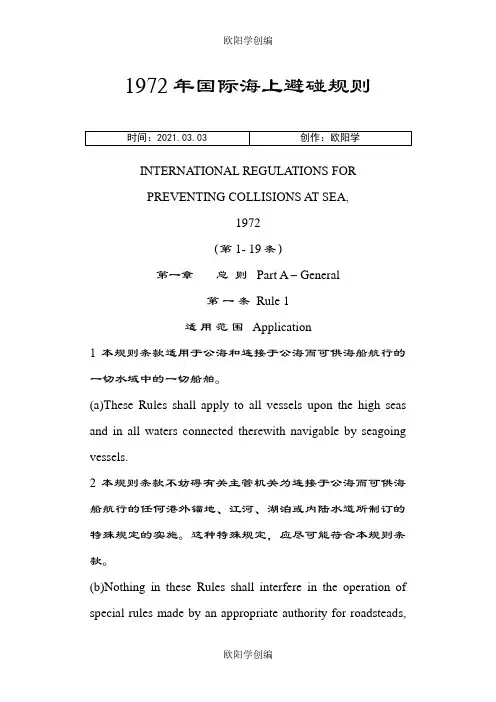
1972年国际海上避碰规则INTERNATIONAL REGULATIONS FORPREVENTING COLLISIONS AT SEA,1972(第1- 19条)第一章总则 Part A – General第一条 Rule 1适用范围 Application1 本规则条款适用于公海和连接于公海而可供海船航行的一切水域中的一切船舶。
(a)These Rules shall apply to all vessels upon the high seas and in all waters connected therewith navigable by seagoing vessels.2本规则条款不妨碍有关主管机关为连接于公海而可供海船航行的任何港外锚地、江河、湖泊或内陆水道所制订的特殊规定的实施。
这种特殊规定,应尽可能符合本规则条款。
(b)Nothing in these Rules shall interfere in the operation of special rules made by an appropriate authority for roadsteads,harbors, rivers, lakes or inland waterways connected with the high seas and navigable by seagoing vessels. Such special rules shall conform as closely as possible to these Rules.3.本规则条款不妨碍各国政府为军舰及护航下的船舶所制定的关于额外的队形灯、信号灯、号型或笛号,或者为结队从事捕鱼的渔船所制定的关于额外的队形灯、信号灯或号型的任何特殊规定的实施。
这些额外的队形灯、信号灯、号型或笛号,应尽可能不致被误认为本规则其他条文所规定的任何号灯、号型或信号。
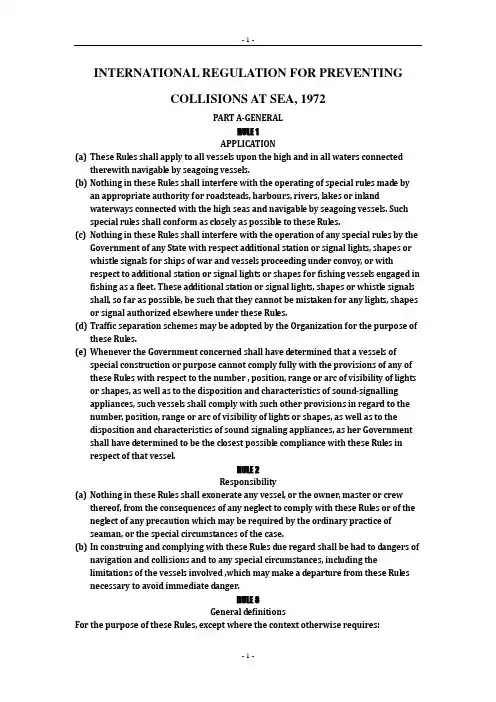
INTERNATIONAL REGULATION FOR PREVENTINGCOLLISIONS AT SEA, 1972PART A-GENERALRULE 1APPLICATION(a)These Rules shall apply to all vessels upon the high and in all watersconnected therewith navigable by seagoing vessels.(b)Nothing in these Rules shall interfere with the operating of special rulesmade by an appropriate authority for roadsteads, harbours, rivers, lakes or inland waterways connected with the high seas and navigable byseagoing vessels. Such special rules shall conform as closely as possible to these Rules.(c)Nothing in these Rules shall interfere with the operation of any specialrules by the Government of any State with respect additional station or signal lights, shapes or whistle signals for ships of war and vesselsproceeding under convoy, or with respect to additional station or signal lights or shapes for fishing vessels engaged in fishing as a fleet. These additional station or signal lights, shapes or whistle signals shall, so far as possible, be such that they cannot be mistaken for any lights, shapes or signal authorized elsewhere under these Rules.(d)Traffic separation schemes may be adopted by the Organization for thepurpose of these Rules.(e)Whenever the Government concerned shall have determined that avessels of special construction or purpose cannot comply fully with the provisions of any of these Rules with respect to the number , position, range or arc of visibility of lights or shapes, as well as to the disposition and characteristics of sound-signalling appliances, such vessels shall comply with such other provisions in regard to the number, position, range or arc of visibility of lights or shapes, as well as to the disposition and characteristics of sound signaling appliances, as her Government shall have determined to be the closest possible compliance with these Rules in respect of that vessel.RULE 2Responsibility(a)Nothing in these Rules shall exonerate any vessel, or the owner, masteror crew thereof, from the consequences of any neglect to comply with these Rules or of the neglect of any precaution which may be required by the ordinary practice of seaman, or the special circumstances of the case.(b)In construing and complying with these Rules due regard shall be had todangers of navigation and collisions and to any special circumstances, including the limitations of the vessels involved ,which may make adeparture from these Rules necessary to avoid immediate danger.RULE 3General definitionsFor the purpose of these Rules, except where the context otherwise requires: (a)The word ”vessel”include every description of water craft, includingnon-displacement craft and seaplanes, used or capable of being used as a means of transportations on water.(b)The term ”power-driven vessel”means any vessel propelled bymachinery.(c)The term ”sailing vessel”means any vessel under sail provided thatpropelling machinery, if fitted , is not being used.(d)The term “vessel engaged in fishing apparatus which restrictmanoeuvrability , but dose not include a vessel fishing with trolling lines or other fishing apparatus which do not restrict manoeuvrability.(e)The word “seaplane” includes any aircraft designed to maneuver on thewater.(f)The term “vessel not under command “means a vessel which throughsome exceptional circumstance is unable to maneuver as required by these Rules and is therefore unable to keep out of the way of another vessel.(g)The term “vessel restricted in her ability of maneuver”means a vesselwhich from the nature of her work is restricted in her ability to maneuver as required by these Rules and is therefore unable to keep out of the way of another vessel. The term ”vessels restricted in their ability to maneuver” shall include but be limited to :(i)a vessel engaged in laying, servicing or picking up a navigation mark,submarine cable or pipeline;(ii)a vessel engaged in replenishment or transferring persons, provisions or cargo while underway;(iii)a vessel engaged in the launching or recovery of aircraft ;(v)a vessel engaged in a towing operation such as severely restricts the towing vessel and her tow in their ability to deviate from their course .(h)The term “vessel constrained by her draught “means a power-drivenvessel which , because of her draught in relation to the available depth and width of navigable water, is severely restricted in her ability to deviate from the course she is following.(i)The word “underway “means that a vessel is not at anchor, or made fastto the shore, or aground.(j)The words “length” and “breadth” of a vessel mean her length overall and greatest breadth.(k)Vessels shall be deemed to be in sight of one another only when one can be observed visually from the other.(l)The term “restricted visibility” means any condition in which visibility is restricted by fog, mist falling snow, heavy rain-storm, sandstorms or any other similar cause.PART B-STEERING AND SAILING RULESSection I-conduct of vessels in anyCondition of visibilityRULE 4ApplicationRules in this section apply in any condition of visibility.RULE 5Look-outEvery vessel shall at all times maintain a proper look-out by sight and hearing as by all available means appropriate in the prevailing circumstances and conditions so as to make a full appraisal of the situation and of the risk of collision.RULE 6Safe speedEvery vessel shall at all times proceed at a safe speed so that she can take proper and effective action to avoid collision and be stopped within a distance appropriate to the prevailing circumstances and conditions.In determining a safe speed the following factors shall be among those taken into account:(a)By all vessels:(i)the state of visibility;(ii)the traffic density including concentrations of fishing vessels or any other vessels;(iii)the manoeuvrability of the vessel with special reference to stopping distance and turning ability in the prevailing conditions;(iv)at night the presence of background light such as from shore lights of from back scatter other own lights;(v)the state of wind , sea and current , and the proximity of navigational hazards;(vi)the draught in relation to the available depth of water.(b)Additionally, by vessels with operational radar:(i)the characteristics, efficiency and limitations of the radar equipment;(ii)any constraints imposed by the radar rang scale in use;(iii)the effect on radar detection of the sea state, weather and other sources of interference;(iv)the possibility that small vessels, ice and other floating objects may not be detected by radar at an adequate range;(v)the number , location and movement of vessels detected by radar;(vi)the more exact assessment of the visibility that may be possible when radar is used to determine the range of vessels or other objects in the vicinity.RULE 7Risk of collision(a)Every vessel shall use all available means appropriate to the prevailingcircumstances and conditions to determine if risk of collision exists. If there is any doubt such risk shall be deemed to exist.(b)Proper use shall be made of radar equipment if fitted and operational,including long-range scanning to obtain early warning of risk of collision and radar plotting or equivalent systematic observation of detected objects.(c)Assumptions shall not be made on the basis of scanty information,especially scanty radar information.(d)In determining if risk of collision exists the following considerationsshall be among those taken into account:(i)such risk shall be deemed to exist if the compass bearing of anapproaching vessel does not appreciably change;(ii)such risk may sometimes exist even when an appreciable bearing change is evident ,particularly when approaching a very large vessel or a tow or when approaching a vessel at close range.RULE 8Action to avid collision(a)Any action to avoid collision shall, if the circumstances of the case admit,be positive, good seamanship. made in ample time and with due regard to the observance of(b)Any alteration of course and/or speed to avoid collision shall, if thecircumstances of the case admit, be large enough to be readily apparent to another vessel observing visually or by radar; a succession of small alterations of course and/or speed should be avoided.(c)If there is sufficient sea-room, alteration of course alone may be the mosteffective action to avoid a close-quarters situation provided that it is made in good time, is substantial and dose not result in another close-quarter situation.(d)Action taken to avoid collision with another vessel shall be such as toresult in passing at a safe distance. The effectiveness of the action shall be carefully checked until the other vessel is finally past and clear(e)If necessary to avoid collision or allow more time to assess the situation,a vessel shall slacken her speed or take all way off by stopping orreversing her means of propulsion(f)(i)A vessel which, by any of these Rules, is required not to impede thepassage or safe passage of another vessel shall, when required by the circumstances of the case, take early action to allow sufficient sea-room for the safe passage of the other vessel.(ii)A vessel required not to impede the passage or safe passage of another vessel is not relieved of this obligation if approaching the other vessel so as to involve risk of collision and shall, when taking action, have full regard to the action which nay be required by the Rules of these part (iii)A vessel the passage of which is not to be impeded remains fullyobliged to comply with the Rules of this part when the two vessels art approaching one another so as to involve risk of collision.RULE 9Narrow channels(a)A vessel proceeding along the course of a narrow channel or fairwayshall keep as near to the outer limit of the channel or fairway which lies on her starboard side as is safe and practicable(b)A vessel of less than 20metres in length or sailing vessel shall not impedethe passage of a vessel which can safely navigate only within a narrow channel or fairway.(c)A vessel engaged in fishing shall not impede the passage of any othervessel navigating with a narrow channel or fairway.(d)A vessel shall not cross a narrow channel or fairway if such crossingimpedes the passage of a vessel which can safely navigate only within such channel or fairway. The latter vessel may use the intention of crossing vessel.(e)(i)In a narrow channel or fairway when overtaking can take place only ifthe vessel to be overtaken has to take action to permit safe passing, the vessel intending to overtake shall indicate her intention by sounding the appropriate signal prescribed in rule34 (c)(i).The vessel to be overtaken shall, if in agreement, sound the appropriate signal prescribed in rule 34(c)(ii)and take steps to permit safe passing. If in doubt she may sound the signals prescribed in Rule 34(d).(ii)This Rule dose not relieved the overtaking vessel of her obligation under Rule 13.(f)A vessel nearing a bend or an area of a narrow channel or fairway whereother vessels may be obscured by an intervening obstruction shall navigate with particular alter ness and caution and shall sound the appropriate signal prescribed in Rule 34(e).(g)Any vessel shall, if the circumstances of the case admit, avoid anchoringin a narrow channel.RULE 10Traffic separation schemes(a)This Rule applies to traffic separation schemes adopted by theOrganization and does not relieve any vessel of her obligation under any other rule.(b)A vessel using a traffic separation schemes shall;(i)proceed in the appropriate traffic lane in the general direction oftraffic flow for that lane;(ii)so far as practicable keep cleat of a traffic separation line or separation zone;(iii)normally join or leave a traffic lane at the termination of the land, but when joining or leaving from either side shall do so at as small an angle to the general direction of traffic flow as practicable.(c)A vessel shall, so far as practicable , avoid crossing traffic lanes but ifobliged to do so shall cross on a heading as nearly as practicable at right angles to the general direction of traffic flow.(d)(i)A vessel shall not use an inshore traffic zone when she can safely usethe appropriate traffic lane within the adjacent traffic separation schemes. However, vessels of less than 20metres in length, sailing vessel and engaged in fishing may use the inshore traffic zone.(ii)Notwithstanding subparagraph (d) (i).a vessel may use an inshore traffic zone when en route to or from a port, offshore installation or structure, pilot station or any other place situated within the inshore traffic zone, or to avoid immediate danger.(e)A vessel other than a crossing vessel or a vessel joining or leaving a laneshall not normally enter a separation zone or cross a separation line except:(i)in case of emergency to avoid immediate danger;(ii)to engage in fishing within a separation zone.(f)A vessel navigating in areas near the terminations of traffic separationschemes shall do so with particular caution.(g)A vessel shall so far as practicable avoid anchoring in a traffic separationscheme or in areas near its terminations.(h)A vessel not using a traffic separation schemes shall avoid it by as wide amargin as is practicable.(i)A vessel engaged in fishing shall not impede the passage of any vesselfollowing a traffic lane.(j)A vessel of less than 20metres in length or a sailing vessel shall not impede the safe passage of a power-driven vessel following a traffic lane. (k)A vessel restricted in her ability to manoeuvre when engaged in an operation for the maintenance of safety of navigation in a traffic separation schemes is exempted from complying with this Rule to the extent necessary to carry out the operation.(l)A vessel restricted in her ability to manoeuvre when engaged in an operation for the laying, servicing or picking up of a submarine cable, within a traffic separation schemes, is exempted from complying with this Rule to the extent to the necessary to carry out the operation.Section II-Conduct of vessel in sight of one anotherRULE 11ApplicationRules in this section apply to vessels in sight of one another.RULE12Sailing vessels(a)When two sailing vessels are approaching one another, so at to involverisk of collision, one of them shall keep out of the way of the other as following;(i)when each has the wind on a different side, the vessel which has thewind on the port side shall keep out of the way of the other;(ii)when both have the wind on the same side, the vessel which is to windward shall keep out of the way of the vessel which is to leeward;(iii)if a vessel with the wind on the port side sees a vessel to windward and cannot determine with certainty whether the other vessel has the wind on the port or on the starboard side, she shall keep out of the way of the other.(b)For the purpose of this Rule the windward side shall be deemed to be theside opposite to that on which the mainsail is carried or, in the case of a square-rigged vessel, the side opposite to that on which the largest fore and-aft sail is carried.RULE 13Overtaking(a)Notwithstanding anything contained in the Rule of part B, sections I andII, any vessel overtaking any other shall keep out of the way of the vessel being overtaken.(b)A vessel shall be deemed to be overtaking when coming up with anothervessel from a direction more than 22.5degress abaft her beam, that is, in such a position with reference to the vessel she is overtaking, that at night she would be able to see only the stern light of that vessel but neither of her sidelight.(c)When a vessel is in any doubt as to whether she is overtaking another,she shall assume that this is the case and act accordingly.(d)Any subsequent alteration of the bearing between the two vessels shallnot make the overtaking vessel a crossing vessel within the meaning of these Rules or relieve her of the duty of keeping clear of the overtaken vessel until she is finally past and clear.RULE 14Head-on situation(a)When two power-driven vessels are meeting on reciprocal or nearlyreciprocal courses so as to involve risk of collision each shall alter her course to starboard so that each shall pass on the port side of the other.(b)Such a situation shall be deemed to exist when a vessel sees the otherahead or nearly ahead and by night she could see the masthead lights of the other in a line or nearly in a line and/or both sidelight and by she observes the corresponding aspect of the other vessel.(c)When a vessel is in any doubt as to whether such a situation exists sheshall assume that it does exist and act accordingly.RULE 15Crossing situationWhen tow power-driven vessels are crossing so as to involve risk of collision, the vessel which has the other on her own starboard side shall keep out of the way and shall, if the circumstances of the case admit, avoid crossing ahead of the other vessel.RULE 16Action by give-way vesselEvery vessel which is directed to keep out of the way of another vessel shall, so far as possible, take early and substantial action to keep well clear.RULE 17(a)(i)Where one of two vessels is to keep out of the way the other shall keepher course and speed.(ii)The latter vessel may however take action to avoid collision by her manoeuvre alone, as soon as it becomes apparent to her that the vessel required to keep out of the way is not taking appropriate action in compliance with these Rules.(b)When, from any cause, the vessel required to keep her course and speedfinds herself so close that collision cannot be avoided by the action of the give-way vessel alone, she shall take such action as will best aid to avoid collision.(c) A Power-driven vessel which takes action in a crossing situation inaccordance with subparagraph (a)(ii)of this Rule to avoid collision with another power-driven vessel shall, if the circumstances of the case admit, not alter course to port for a vessel on her own port side.(d)This Rule does not relieve the give-way vessel of her obligation to keepout of the way.RULE 18Responsibilities between vesselsExcept where Rules9, 10and 13 otherwise required:(a) A power-driven vessel underway shall keep out of the way of:(i)a vessel not under command;(ii)a vessel restricted in her ability to manoeuvre;(iii)a vessel engaged in fishing;(iv)a sailing vessel.(b)A sailing vessel underway shall keep out of the way of:(i)a vessel not under command;(ii)a vessel restricted in her ability to manoeuvre;(iii)a vessel engaged in fishing.(c) A vessel engaged in fishing when underway shall, so far as possible, keepout of the way of:(i)a vessel not under command;(ii)a vessel restricted in her ability to manoeuvre.(d)(i)Any vessel other than a vessel not under command or a vesselrestricted in her ability to manoeuvre shall, if the circumstances of the case admit, avoid impeding the safe passage of a vessel constrained by her draught, exhibiting the signal in Rule 28.(ii)A vessel constrained by her draught shall navigate with particular caution having full regard to her special condition.(e) A seaplane on the water shall, in general, keep well clear of all vesselsand avoid impeding their navigation. In circumstances, however, where risk of collision exists, she shall comply with Rules of this part.Section III-Conduct of vessels in restricted visibilityRULE 19Conduct of vessels in restricted visibility(a)This Rule applies to vessels not in sight of one another when navigatingin or near an area of restricted visibility(b)Every vessel shall proceed at a sage speed adapted to the prevailingcircumstances and conditions of restricted visibility. A power-driver vessel shall have her engines ready for immediate manoeuvre.(c)Every vessel shall have due regard to the prevailing circumstances andconditions of restricted visibility when complying with the Rules of section I of this part.(d)A vessel which detected by radar alone the presence of another vesselshall determine if a close-quarters situation is developing and/or risk of collision exists. If so, she shall take avoiding action in ample time, provided that when such action consists of an alteration of course, so far as possible the following shall be avoided;(i)an alteration of course to port for a Vessel forward of the beam, otherthan for a Vessel being ever taken;(ii)an alteration of course towards a vessel abeam or abaft the beam. (e)Except where it has been determined that a risk of collision does notexist, every vessel which hears apparently forward of her beam the fog signal of another vessel, or which cannot avoid a close-quarters situation with another vessel forward of her beam, shall reduce her speed to the minimum at which she can be kept on her course. She shall if necessary take all her way off and in any event navigate with extreme caution until danger of collision is over.PART C-LIGHTS AND SHAPESRULE 20Application(a)Rules in this part shall be complied with in all weathers.(b)The Rules concerning lights shall be complied with from sunset tosunrise, an during such times on other lights shall be exhibited, except such lights as can not be mistaken for the lights specified in these Rules or do not impair their visibility or distinctive character, or interfere with the keeping of a proper look-out(c)The lights prescribed by these Rules shall, if carried, also be exhibitedfrom sunrise to sunset in restricted visibility and may be exhibited in all other circumstances when it is deemed necessary.(d)The Rules concerning shapes shall be complied with by day.(e)The lights and shapes specified in these Rules shall comply with theprovisions of Annex I to these Regulations.RULE 21Definitions(a)”Masthead light”means a white light placed over the fore and aftcentreline of the vessel showing an unbroken light over an arc of the horizon of 225 degrees and so fixed as to show the light from right ahead to 22.5 degrees abaft the beam on either side the vessel.(b)“Side lights” means a green light on the starboard side and a red light onthe port side each showing an unbroken light over an arc of the horizon of 112.5 degrees and so fixed as to show the light from right ahead to 22.5 degrees abaft the beam on its respective side. In a vessel of less than 20metres in length the sidelights may be combined in one lantern carried on the fore and aft centerline of the vessel.(c)“Stern light” means a white light placed as nearly as practicable at thestern showing an unbroken light over an arc of the horizon of 135 degrees and so fixed as to show the light 67.5 degrees from right aft on each side of the vessel.(d)“Towing light” means a yellow light having the same characteristics asthe “stern light” defined in paragraph (c) of this Rules.(e)“All-round light” means a light showing an unbroken light over an arc ofthe horizon of 360 degrees.(f)“Flashing light”means a light flashing at regular intervals at afrequency of 120 flashes or more minute.RULE 22Visibility of lightThe lights prescribed in these Rules shall have an intensity as specified in section 8 of Annex I to these Regulations so as to be visible at the following minimum ranges:(a)In vessels of 50metres or more in length:--a masthead light, 6 miles;--a sidelight, 3 miles;--a stern light, 3 miles;--a towing light, 3 miles;--a white, red, green or yellow all-round light,3 miles.(b)In vessels in 12metres or more in length but less than 50metres in length:--a masthead light, 5miles; except that where the length of the vessel is less than 20metres, 3 miles;--a sidelight,2 miles;--a stern light, 2 miles;--a towing light, 2 miles;--a white, red, green or yellow all-round light, 2 miles.(c)In vessels of less than 12metres in length:--a masthead light, 2 miles;--a sidelight, 1 miles;--a stern light, 2 miles;--a towing light, 2 miles;--a white, red, green or yellow all-round light, 2 miles.(d)In inconspicuous, partly submerged vessels or objects being towed:--a white all-round light, 3 miles.RULE 23Power-driven vessels underway(a)A power-driven vessel underway shall exhibit:(i)a masthead light forward;(ii)a second masthead light abaft of and higher than the forward one;except that a vessel of less than 50metres in length shall not be obliged to exhibit such light but may do so;(iii)sidelights;(iv)a stern light(b)An air-cushion vessel when operating in the non-displacement modeshall, in addition to the lights prescribed in paragraph(a) of this Rule, exhibit an all-round flashing yellow light;(c)(i)A power-driven vessel of less than 12meters in length may in lieu of thelights prescribed in paragraph (a) of this Rule, exhibit an all-round white light and sidelights.(ii)a power-driven vessel of less than 7metres in length whose maximum speed does not exceed 7 knots may in lieu of the lights prescribed in paragraph (a) of this Rule exhibit an all-round white light and shall, if practicable, also exhibit sidelights;(iii)the masthead light or all-round white light on a power-driven vessel of less than 12metres in length may be displaced from the fore and aft centerline of the vessel if centerline fitting is not practicable, provided that the sidelights are combined in the same fore and aft line as the masthead light or the all-round white light.RULE 24Towing and pushing(a)A power-driven vessel when towing shall exhibit:(i)instead of the light in Rule 23(a)(i)or (a)(ii) , two masthead lights in avertical line, when the length of the tow, measuring from the stern of the towing vessel to the after end of the tow exceeds 200meters, three such lights in a vertical line;(ii)sidelights;(iii)a stern light;(iv)a towing light in a vertical line above the stern light;(v)when the length of the tow exceeds 200metres, a diamond shape where it can best be seen.(b)When a pushing vessel and a vessel being pushed are rigidly connected ina composite unit they shall be regarded as a power-driven vessel andexhibit the lights prescribed in Rule 23.(c)A power-driven vessel when pushing ahead or towing alongside, exceptin the case of a composite unit, shall exhibit:(i)instead of the light prescribed in Rule 23(a)(i)or(a)(ii), two mastheadlights in a vertical line;(ii)sidelights;(iii)a stern light.(d)A power-driven vessel to which paragraph (a) or (c) or this Rule appliesshall also comply with Rule 23 (a) (ii).(e)A vessel or object being towed, other than those mentioned in paragraph(g) of this Rule, shall exhibit:(i)sidelights;(ii)a stern light;(iii)when the length of the tow exceeds 200metres, a diamond shape where it can best be seen.(f)Provided that any number of vessels being towed alongside or pushed ina group shall be lighted as one vessel,(i)a vessel being pushed ahead, not being part of a composite unit, shallexhibit at the forward end, sidelight;(ii)a vessel being towed alongside shall exhibit a stern light and at the forward end, sidelights.(g)An inconspicuous, partly submerged vessel or object, or combination ofsuch vessels or objects being towed, shall exhibit:(i)if it is less than 25metres in breadth, one all-round white light at ornear the forward end and one at all-round white light at or near the after end except that dracones need not exhibit a light at or near the forward end;(ii)if it is 25metres or more in breadth, two additional all-round white lights at or near the extremities of its breadth;(iii)if it exceeds 100metres in length, additional all-round white lights between the lights prescribed in subparagraphs (i) and (ii) so that the distance between the lights shall not exceed 100metres;(iv)a diamond shape at or near the aftermost extremity of the last vessel or object being towed and if the length of the tow exceeds 200metres an additional diamond shape where it can best be seen and located as far forward as is practicable.(h)Where from any sufficient cause it is impracticable for a vessel or objectbeing towed to exhibit the lights or shapes prescribed in paragraph(e)or(g) of this Rule, all possible measures shall be taken to light the vessel orobject towed or at least to indicate the presence of such vessel or object.(i)Where from any sufficient cause it is impracticable for a vessel notnormally engaged in towing operations to display the lights prescribed in paragraph(a)or(c) of this Rule, such vessel shall not be required to exhibit those lights when engaged in towing another vessel in distress or otherwise in need or assistance. All possible measures shall be taken to indicate the mature of the relationship between the towing vessel and。

1972年国际海上避碰规则INTERNATIONAL REGULATIONS FORPREVENTING COLLISIONS AT SEA,1972(第1- 19条)第一章总则 Part A – General第一条 Rule 1适用范围 Application1 本规则条款适用于公海和连接于公海而可供海船航行的一切水域中的一切船舶。
(a)These Rules shall apply to all vessels upon the high seas and in all waters connected therewith navigable by seagoing vessels. 2本规则条款不妨碍有关主管机关为连接于公海而可供海船航行的任何港外锚地、江河、湖泊或内陆水道所制订的特殊规定的实施。
这种特殊规定,应尽可能符合本规则条款。
(b)Nothing in these Rules shall interfere in the operation of special rules made by an appropriate authority for roadsteads, harbors, rivers, lakes or inland waterways connected with the high seas and navigable by seagoing vessels. Such special rulesshall conform as closely as possible to these Rules.3.本规则条款不妨碍各国政府为军舰及护航下的船舶所制定的关于额外的队形灯、信号灯、号型或笛号,或者为结队从事捕鱼的渔船所制定的关于额外的队形灯、信号灯或号型的任何特殊规定的实施。
这些额外的队形灯、信号灯、号型或笛号,应尽可能不致被误认为本规则其他条文所规定的任何号灯、号型或信号。
1972年国际海上避碰规则第一章总则第一条适用范围1.本规则各条适用于在公海和连接于公海而可供海船航行的一切水域中的一切船舶。
2.本规则各条不妨碍有关主管机关为连接于公海而可供海船航行的任何港外锚地、港口、江河、湖泊或内陆水道所制订的特殊规定的实施。
这种特殊规定,应尽可能符合本规则各条。
3.本规则各条,不妨障各国政府为军舰及护航下的船舶所制订的关于额外的队形灯、信号灯、号型或笛号,或者为结队从事捕鱼的渔船所制定的关于额外的队形灯、信号灯或号型的任何特殊规定的实施。
这些额外的队形灯、信号灯、号型或笛号,应尽可能不致被误认为本规则其他条文所规定的任何号灯、号型或信号。
4.为实施本规则,本组织可以采纳分道通航制。
5.凡经有关政府确定,某种特殊构造或用途的船舶,如须完全遵守本规则任何一条关于号灯或号型的数量、位置、能见距离或弧度以及声号设备的配置和特性的规定,就不能不影响其特殊功能时,则应遵守其政府在号灯或号型的数量、位置、能见距离或弧度以及声号设备的配置和特性方面为之另行确定的,尽可能符合本规则所要求的规定。
第二条责任1.本规则各条并不免除任何船舶或其所有人,船长或船员由于对遵守本规则各条的任何疏忽,或者对海员通常做法或当时特殊情况可能要求的任何戒备上的疏忽而产生的各种后果的责任。
2.在解释和遵行本规则各条规定时,应适当考虑到,为避免紧迫危险而须背离本规则各条规定的一切航行和碰撞的危险,以及任何特殊情况,其中包括当事船舶条件限制在内。
第三条一般定义除其他条文另有解释外,在本规则中:1.“船舶”一词,指用作或者能够用作水上运输工具的各类水上船筏,包括非排水船舶和水上飞机。
2.“机动船”一词,指用机器推进的任何船舶。
3.“帆船”一词,指任何驶帆的船舶,包括装有推进机器而不在使用者。
4.“从事捕鱼的船舶”一词,指使用网具、绳钓、拖网或其他使其操纵性能受到限制的渔具捕鱼的任何船舶,但不包括使用曳绳钓或其他并不使其操纵性能受到限制的渔具捕鱼的船舶。
中华人民共和国交通部公告第15号关于《1972年国际海上避碰规则》2001年修正案生效的通知国际海事组织于2001年11月29日以第A.910(22)号大会决议通过了一项对《1972年国际海上避碰规则》的修正案,根据该大会决议和《1972年国际海上避碰规则公约》第VI条第4款的规定,该修正案将通过默认接受程序于2003年11月29日生效。
我国是《1972年国际海上避碰规则公约》的当事国,在上述修正案通过以后,没有对其内容提出过异议。
因此,该修正案将对我国具有约束力。
现将该修正案公告,请遵照执行。
中华人民共和国交通部2003年9月28日1972 年国际海上避碰规则(经2001修正案修正)第一章总则第一条适用范围1.本规则条款适用于在公海和连接于公海而可供海船航行的一切水域中的一切船舶。
2.本规则条款不妨碍有关主管机关为连接于公海而可供海船航行的任何港外锚地、港口、江河、湖泊或内陆水道所制订的特殊规定的实施。
这种特殊规定,应尽可能符合本规则条款。
3.本规则条款不妨碍各国政府为军舰与护航下的船舶所制定的关于额外的队形灯、信号灯、号型或号笛,或者为结队从事捕鱼的渔船所制定的关于额外的队形灯、信号灯、号型的任何特殊规定的实施。
这些额外的队形灯、信号灯、号型或笛号,应尽可能不致被误认为本规则其他条文所规定的任何号灯、号型或信号。
4.为实施本规则,本组织可以采纳分道通航制。
5.凡经有关政府确定,某种特殊结构或用途的船舶,如不能完全遵守本规则任何一条关于号灯或号型的数量、位置、能见距离或弧度以与声号设备的配置和特性的规定时,则应遵守其政府在号灯或号型的数量、位置、能见距离或弧度以与声号设备的配置和特性方面为之另行确定的尽可能符合本规则条款要求的规定。
第二条责任1.本规则条款并不免除任何船舶或其所有人、船长或船员由于遵守本规则条款的任何疏忽,或者按海员通常做法或当时特殊情况所要求的任何戒备上的疏忽而产生的各种后果的责任。
1972年国际海上避碰规则第一章总则第一条适用范围1.本规则各条适用于在公海和连接于公海而可供海船航行的一切水域中的一切船舶。
2.本规则各条不妨碍有关主管机关为连接于公海而可供海船航行的任何港外锚地、港口、江河、湖泊或内陆水道所制订的特殊规定的实施。
这种特殊规定,应尽可能符合本规则各条。
3.本规则各条,不妨障各国政府为军舰及护航下的船舶所制订的关于额外的队形灯、信号灯、号型或笛号,或者为结队从事捕鱼的渔船所制定的关于额外的队形灯、信号灯或号型的任何特殊规定的实施。
这些额外的队形灯、信号灯、号型或笛号,应尽可能不致被误认为本规则其他条文所规定的任何号灯、号型或信号。
4.为实施本规则,本组织可以采纳分道通航制。
5.凡经有关政府确定,某种特殊构造或用途的船舶,如须完全遵守本规则任何一条关于号灯或号型的数量、位置、能见距离或弧度以及声号设备的配置和特性的规定,就不能不影响其特殊功能时,则应遵守其政府在号灯或号型的数量、位置、能见距离或弧度以及声号设备的配置和特性方面为之另行确定的,尽可能符合本规则所要求的规定。
第二条责任1.本规则各条并不免除任何船舶或其所有人,船长或船员由于对遵守本规则各条的任何疏忽,或者对海员通常做法或当时特殊情况可能要求的任何戒备上的疏忽而产生的各种后果的责任。
2.在解释和遵行本规则各条规定时,应适当考虑到,为避免紧迫危险而须背离本规则各条规定的一切航行和碰撞的危险,以及任何特殊情况,其中包括当事船舶条件限制在内。
第三条一般定义除其他条文另有解释外,在本规则中:1.“船舶”一词,指用作或者能够用作水上运输工具的各类水上船筏,包括非排水船舶和水上飞机。
2.“机动船”一词,指用机器推进的任何船舶。
3.“帆船”一词,指任何驶帆的船舶,包括装有推进机器而不在使用者。
4.“从事捕鱼的船舶”一词,指使用网具、绳钓、拖网或其他使其操纵性能受到限制的渔具捕鱼的任何船舶,但不包括使用曳绳钓或其他并不使其操纵性能受到限制的渔具捕鱼的船舶。
IMO 第22届大会通过的1972年国际海上避碰规则修正案国际海事组织(IMO)TXH22届大会以A.910(22)号决议通过了“1972年国际海上避碰规则”的修正案新增了地效翼船的定义及有关要求,修改了长度为12米上小于20米船舶的号笛和号鈡的配备要求,附录三、声号器具的技术细节以高速船桅灯高度的要求。
该修正案将于2003年11月29日生效。
对适用的船舶(如:地效翼船等),在本通函生效后:1、新船应在交船出厂前,确认满足本修正案的要求;2、现有船应在第一次设备安全的定期检验但不迟于2003年11月29日前确认满足本修正案的要求。
附件:1972年国际海上避碰规则修正案1972 年国际海上避碰规则修正案第一章总则第一条适用范围1、本规则条款适用于公海和连接公海而可供海船航行的一切水域中的一切船舶。
2、本规则条款不妨碍有关主管机关为连接于公海而可供海船航行的任何港外锚地、港口、江河、湖泊或内陆水道所制订的特殊规定的实施。
这种特殊规定,应尽可能符合本规则条款。
3、本规则条款不妨碍各国政府为军舰及护航下的船舶所制定的关于额外的队形灯、信号灯、号型或笛号、或者为结队从事捕鱼的渔船所制定的关于额外的队形灯、信号灯、号型或任何特殊规定的实施。
这些额外的队形灯、信号灯、号型或笛号,应尽可能不致被误认为本规则其他条文所规定的任何号灯、号型或型号。
4、为实施本规则,本组织可以采纳分道通航制。
5、凡经有关政府确定,某种特殊构造或用途的船舶,如不能完全遵守本规则任何一条关于号灯或号型的数量、位置、能见距离或弧度以及声号设备的配置和特性的规定时,则应遵守其政府在号灯或号型的数量、位置、能见距离或弧度以及声号设备的配置和特性方面为之另行确定的尽可能符合本规则条款要求的规定。
第二条责任1、本规则条款并不免除任何船舶或其所有人、船长或船员由于遵守本规则条款的任何疏忽,或者按海员通常做法或当时特殊情况所要求的任何戒备上的疏忽而产生的各种后果的责任。
Regulations for Preventing Collisions at Sea. 1972PART A ──GENERALRule 1Application(a) These Rules shall to all vessels upon the high seas and in all waters connectedthere with navigable by sea going vessels.(b) Nothing in these Rules shall interfere with the operation of special rules madeby an appropriate authority for roadsteads, harbours, rivers, lakes or inland waterways connected with the high seas and navigable by sea- going vessels.Such special rules shall conform as closely as possible to these Rules.(c) Nothing in these Rules shall interfere with the operation of any special rulesmade by the Government of any State with respect to additional station or signal lights, shapes or whistle signals for ships of war and vessels proceeding under convoy, or with respect to additional station or shapes for fishing vessels engaged in fishing as a fleet. These additional station or signal lights, shapes or whistle signals shall, so far as possible, be such that they cannot be mistaken for any light, shape or signal authorized elsewhere under these Rules.(d) Traffic separation schemes may be adopted by the Organization for thepurpose of these Rules.(e) Whenever the Government concerned shall have determined that a vessel ofspecial construction or purpose cannot comply fully with the provisions of any of these Rules with respect to the number, position, range or arc of visibility of lights or shapes, as well as to the disposition and characteristics of sound-signaling appliances, such vessel shall comply with such other provisions in regard to the number, position, range or arc of visibility of lights or shapes, as well as to the disposition and characteristics of sound- signaling appliances, as her Government shall have determined to be the closest possible compliance with these Rules in respect of that vessel.第一条适用范围1.本规则适用于公海和连接于公海而可供海船航行的一切水域中的一切船舶.2.本规则不妨碍有关主管机关为连接于公海而可供海船航行的任何港外锚地、港口、江河、湖泊或内陆水道所制订的特殊规定的实施。
这种特殊规定,应尽可能符合本规则。
3.本规则不妨碍各国政府为军舰及护航下的船舶所制订的关于额外的队形灯、信号灯、号型或笛号,或者为结对从事捕鱼的渔船所制定的关于额外的队形灯、信号灯、号型或笛号, 应尽可能不致被误认为本规则其他条文所规定的任何号灯、号型或信号。
4.为实施本规则,本组织可以采纳分道通航制。
5.凡经有关政府确定,某种特殊构造或用途的船舶,如不能完全遵守本规则任何一条关于号灯或号型的数量、位置、能见距离或弧度以及声号设备的配置和特性的规定时,则应遵守其政府在号灯或号型的数量、位置、能见距离或弧度以及声号设备的配置和特性方面为之另行确定的尽可能符合本规则要求的规定。
Rule 2Responsibility(a) Nothing in these Rules shall exonerate any vessel, or the owner, master orcrew thereof, from the consequences of any neglect to comply with these Rules or of the neglect of any precaution which may be required by the ordinary practice of seamen, or by the special circumstances of the case. (b) In construing and complying with these Rules due regard shall be had to alldangers of navigation and collision and to any special circumstances, including the limitations of the vessels involved, which may make a departure from these Rules necessary to avoid immediate danger.第二条责任1.本规则并不免除任何船舶或其所有人、船长或船员由于遵守本规则的任何疏忽,或者海员通常做法要求的或当时特殊情况要求的任何戒备上的疏忽而产生的各种后果的责任。
2.在解释和遵守本规则时,应考虑到一切航行和碰撞的危险以及包括当事船舶条件限制在内的任何特殊情况,这些危险和特殊情况可能使船舶在必要时为避免紧迫危险而背离本规则。
Rule 3General DefinitionsFor the purpose of these Rules, except where the context otherwise requires: (a) The word "vessel" includes every description of water craft, including non- displacement craft and seaplanes, used or capable of being used as a means of transportation on water.(b) The term "power- driven vessel" means any vessel under sail provided that propelling machinery, if fitted, is not being used.(d) The term "vessel engaged in fishing" means any vessel fishing with nets, lines, trawls or other fishing apparatus which restrict maneuverability, but does not include a vessel fishing with trolling lines or other fishing apparatus which do not restrict maneuverability.(e) The word "seaplane" includes any aircraft designed to manoeuvre on the water.(f) The term "vessel not under command" means a vessel which through some exceptional circumstance is unable to manoeuvre as required by these Rules and is therefore unable to keep out of the way of another vessel.(g) The term "vessel restricted in her ability to manoeuvre" means a vessel which from the nature of her work is restricted in her ability to manoeuvre as required by these Rules and is therefore unable to keep out of the way of another vessel. The term "vessels restricted in their ability to manoeuvre" shall include but not be limited to:(i) A vessel engaged in laying, servicing or picking up a navigation mark, submarine cable or pipeline;(ii) A vessel engaged in dredging, surveying or underwater operations;(iii) A vessel engaged in replenishment or transferring persons, provisions orcargo while underway;(iv) a vessel engaged in the launching or recovery of aircraft;(v) a vessel engaged in mine clearance operations;(vi) a vessel engaged in a towing operation such as severely restricts the towing vessel and her tow in their ability to deviate from their course.(h) The term "vessel constrained by her draught" means a power-driven vessel which, because of her draught in relation to the available depth and width of navigable water, is severely restricted in her ability to deviate from the course she is following.(i) The word "underway" means that a vessel is not at anchor, or made fast to the shore, or aground.(j) The words "length" and "breadth" of a vessel mean her length overall and greatest breadth.(k) Vessels shall be deemed to be in sight of one another only when one can be observed visually from the other.(L) The term "restricted visibility" means any condition in which visibility is restricted by fog, mist, falling snow, heavy rainstorms, sandstorms or any other similar causes.第三条一般定义除其他条文另有解释外,在本规则中:1.“船舶”一词,指用作或者能够用作水上运输工具的各类水上船筏,包括非排水船舶和水上飞机。